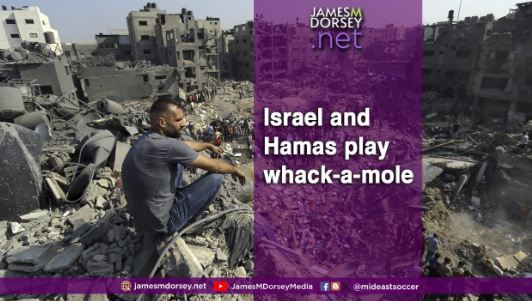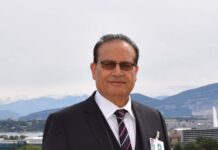Despite its devastating human and physical cost, Israel’s effort to destroy Hamas has a whack-a-mole aspect. Even though Israel asserts it has killed 12,000 of Hama’s estimated 40,000 fighters and wounded or captured thousands more, Hamas retains a presence in swaths of Gaza.
It has been able to re-establish itself, to varying degrees, in areas Israel says it has largely cleansed of militants of Hamas and other armed Palestinian groups.
Continued fighting and Israeli strikes across Gaza in areas it has evacuated suggest it is attacking, among others, positions Hamas re-occupies.
Hamas’ ability to play whack-a-mole is evidence that although Israel has severely damaged the group’s infrastructure, diminished its rank and file, and probably killed (only) one of its top leaders, Israel has failed to destroy Hamas seven months into the war, one of the core goals of its campaign.
Hamas fires rockets from Khan Younis five days after Israel’s withdrawal. Credit: Hindu Times
Earlier this month, Hamas operatives armed with batons began patrolling the streets of Khan Younis in southern Gaza, days after Israeli troops withdrew from the city. Palestinian fighters last week fired rockets from northern Gaza at Kibbutz Aza in Israel.
In February, the Biden administration asked Israel to stop targeting Hamas’ police force that was providing security for aid trucks entering Gaza and attempting to restore a semblance of law and order.
“In the absence of an alternative governance structure and continued inaction, Israel effectively perpetuates Hamas’ civilian rule in Gaza, aiding in its resurgence for years to come,” commented Israeli journalist Yoav Zitun.
Israel’s assault on Gaza has dealt body blows to Hamas in other ways, even if it has unsuccessfully sought to use hunger and lack of medical care as a catalyst for popular revolt against the group.
Palestinians flee their homes in northern Gaza. Credit: Agence France Presse
Splits have emerged between Hamas’ leaders in Gaza, who are believed to be hiding in underground tunnels shielded by hostages abducted during the group’s attack on Israel on October 7 of last year, and its representatives in exileover how to handle ceasefire and prisoner exchange negotiations with Israel and its future strategy.
Hamas is also feeling the heat of growing criticism of the group for provoking the Israeli assault that has devastated Gaza and reduced its 2.3 million inhabitants to destitution.
In late March, Hamas felt compelled to issue a lengthy statement apologising to Gazans for their suffering.
Hamas spokesperson Osama Hamadan addresses Hamas’ apology. Credit: Facebook
Hamas thanked Gazans for their resilience and acknowledged their “exhaustion.” The group said it was trying to alleviate the “difficulties” Gazans faced by among others attempting to impose “price controls,” but its capabilities were limited “because of the ongoing aggression.”
Prices in Gaza have shot up astronomically with, for example, 30 eggs that cost US$2-3 before the war selling for US35-40. Prices have begun to drop with the recent increased flow of food into Gaza.
Hamas said it was discussing ways to “resolve the problems caused by the (Israeli) occupation” with other armed factions, popular committees, and “families,” a reference to clans that Israel has sought to engage in creating an alternative post-war governance structure for Gaza.
At the same time, the statement reiterated that the war would ultimately achieve Palestinian “victory and freedom.”
It’s difficult to assess public sentiments in Gaza.
The Palestine Center for Policy and Survey Research produces the only credible regular public opinion polling in Gaza and the West Bank.
Fifty-two per cent of Gaza respondents in March said they favoured a return to Hamas rule as opposed to the West Bank-based, internationally recognised Palestine Authority, an Arab peacekeeping force, the United Nations, or Israel.
Credit: Palestine Center for Policy and Survey Research
The Center’s polling suggests that Gazan public opinion may be split, but assessments of the strength of anti-Hamas sentiment are primarily based on anecdotal evidence. Moreover, Hamas critics assert that Hamas represses expressions of criticism, complicating the gauging of anti-Hamas sentiment.
“So many Gazans are forced to use aliases and hide their true identities when speaking out against Hamas & the horrendous impact of life under the Islamist group’s violent and authoritarian rule… Conformity is strictly enforced; differing views and alternative opinions will not be tolerated and could result in harassment, attacks, delegitimization, and even violence,” said Ahmed Fouad Alkhatib, an anti-Hamas Palestinian-American, who hails from Gaza, keeps close contact with the Strip, and says he has lost 31 relatives in the seven-month-old Gaza war.
Few will doubt that Hamas does what it can to suppress dissent. Yet, it’s unclear how effective the group can be while under relentless Israeli assault.
Even so, Gazan Hamas critics’ attempts to shield themselves complicate assessments of which social media postings are genuine and which are part of mis- or disinformation campaigns.
Mr. Alkhatib vouches for the authenticity of Mohammed al-Falastin, a Hamas critic he knows personally, who uses a pseudonym to express his views on Twitter.
Ahmed Fouad Alkhatib (right) on News Nation. Credit: Facebook
“Hamas does not represent me, and what happened was not my choice and has nothing to do with me or my family. We are victims of mentally disturbed and mentally ill people who control our lives with iron and fire. I, my family, and many others in Gaza did not choose the path of Hamas,” Mr. Al-Falastin tweeted on April 12.
Reporting in The Atlantic on a recent visit to the Middle East during which he met Gazans living in exile, Mr. Alkhatib, whose brother and family were fired at by Israeli tanks as they fled Gaza City on Israel’s instructions, paints a far more layered picture of the displacement of a majority of the Strip’s population.
Israel insists that it has sought to avoid civilian casualties, in part by distributing millions of leaflets, phone calls, and text messages that called on Palestinians to evacuate to safe zones, which more often proved to be everything but.
Palestinians say that in some instances, they were given as little as a minute to evacuate before Israel attacked their building.
The physical devastation of Gaza and the high casualty rate, which the Gaza health ministry puts at more than 33,000 dead and 70,000+ wounded, suggests that, in the best of cases, Israeli efforts were ineffective.
Mr. Alkhatib does not absolve Israel of responsibility for “horrendous acts against civilians, whether due to indifference, recklessness, or vengefulness.” However, he also points a finger at Hamas.
“The Islamist terror group appears solely focused on its operational and tactical survival, regardless of the strategic consequences of its actions or the damage it inflicts on the Palestinian cause,” Mr. Alkhatib wrote.
Mr. Alkhatib charged that Hamas fighters had placed roadside bombs on Gaza’s north-south Al-Rashid highway in November and opened fire on Palestinians fleeing the north.
Similarly, he charges Hamas, and supportive clerics cite a Quranic verse that prohibits turning one’s back to the enemy when facing them on the battlefield to persuade Gazans to stay in their homes rather than seek safety elsewhere.
Hamas’ strategy was to keep the north populated in a bid to make it more difficult for the Israeli military to operate, according to Mr. Alkhatib.
Hamas may have persuaded some to follow its advice, but the fact that most Gazans are displaced suggests that the Hamas strategy, like the Israeli efforts, largely failed.
Social media and mis-and disinformation scholar Marc Owen Jones took Mr. Alkhatib to task for some of his sourcing.
In doing so, Mr. Jones highlighted Gaza-related information wars that will determine the outcome of the Gaza war as much as developments on the ground.
Mr. Alkhatib hyperlinked an Israeli newspaper report quoting Amjad Taha, a journalist who espouses pro-Israeli and anti-Hamas views and whom Mr. Jones describes as a “known disinfluencer,” as the source for the Al-Rashid incident.
Mr. Alkhatib also hyperlinked an Israeli media report on an Israeli military statement on an earlier incident in which Hamas allegedly killed 70 fleeing Palestinians that has been called into question by independent reporting.
“By all means. criticize Hamas, but not on the basis of non-credible or plausible narratives,” Mr. Jones tweeted in a thread that sought to debunk Mr. AlKhatib’s assertions.
Dr. James M. Dorsey is an Adjunct Senior Fellow at Nanyang Technological University’s S. Rajaratnam School of International Studies, and the author of the syndicated column and podcast, The Turbulent World with James M. Dorsey.

















